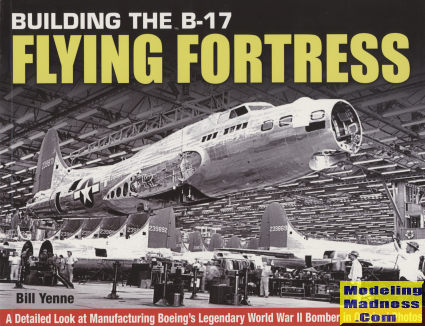 Several
years back, Specialty Press produced a similar book on the P-51 Mustang. Ever
since, I have been wondering if they would do a similar book on another type.
That time of wondering is over as we now have a great one on the B-17 Flying
Fortress. Specialty Press has made the wise choice of
doing this book in landscape format. This allows for the proper handling of
standard format photos in a fairly large size without having to deal with 'the
trench' in the middle of the book.
Several
years back, Specialty Press produced a similar book on the P-51 Mustang. Ever
since, I have been wondering if they would do a similar book on another type.
That time of wondering is over as we now have a great one on the B-17 Flying
Fortress. Specialty Press has made the wise choice of
doing this book in landscape format. This allows for the proper handling of
standard format photos in a fairly large size without having to deal with 'the
trench' in the middle of the book.
The book starts out with a background history of the
aircraft, starting with the XLRB (Extra Long Range Bomber) program of the mid
1930s that resulted in the XB-15 and the XB-19. Both types were huge for the
time, but were not quite what the Air Corps was looking for. Mainly, they were
too large and too expensive. Both aircraft served throughout the war as cargo
transports.
The first bonafide B-17 was the Model 299. It was a
smaller, but more capable aircraft that met the requirements of the time. As
such, a small production contract for the B-17B and later B-17C/D was made so
that production could begin. Both the B-17B and B-17C were not combat ready, but
served well in the training role. Some of the C versions were supplied to the
British, but they were not what was needed in terms of a heavy bomber, though
their long range served them well with Coastal Command. Lessons learned with the
C/D models led to the B-17E. This was the first version to look like what most
of us see as the Fortress and also introduced a tail gun position into the type,
which was to last throughout the rest of aircraft production.
The author uses what are a huge number of photos taken
by Boeing, which includes a few period color photos to illustrate the book. Each
of the different block numbers produced by Boeing, Vega, and Douglas are
covered, indicating what was added (or deleted) between each sub-variation. This
encompasses the bulk of the book and is fascinating reading in and of itself.
There are also parts that cover some of the difficulties overcome. For instance,
the B-17E was the first US bomber to have a proper powered turret. Though the
British had them on their bombers for several years, the US had never used them
before. A ball turret was also something that had to be designed and installed
as it was a new item. It was a steep learning curve. There is also a specific
section on the Cheyenne tail gun position, which was a major improvement over the
earlier one where the gunner had to be on his knees while firing the gun.
As mentioned, it is a great read and includes a ton of
information. One thing I'd like to see changed is that the photos for the
systems discussed in the book are not in the same part of the book with the
description, but several pages later. I see no reason why images of the Cheyenne
gun position, for instance, couldn't be on the same page as the description.
Instead, there are generic construction images and you have to wait 30 pages to
see the turret photos. Perhaps a second edition will take care of situations
like this. Regardless, it is a superb offering and one that I can easily
recommend to you.
June 2021
Copyright ModelingMadness.com. All rights reserved. No
reproduction in part or in whole without express permission.
Review book courtesy of
 ,.
You can order your copy at
this link.
,.
You can order your copy at
this link.
If you would like your product reviewed fairly and fairly quickly, please
contact
me or see other details in the Note to
Contributors.
 Several
years back, Specialty Press produced a similar book on the P-51 Mustang. Ever
since, I have been wondering if they would do a similar book on another type.
That time of wondering is over as we now have a great one on the B-17 Flying
Fortress. Specialty Press has made the wise choice of
doing this book in landscape format. This allows for the proper handling of
standard format photos in a fairly large size without having to deal with 'the
trench' in the middle of the book.
Several
years back, Specialty Press produced a similar book on the P-51 Mustang. Ever
since, I have been wondering if they would do a similar book on another type.
That time of wondering is over as we now have a great one on the B-17 Flying
Fortress. Specialty Press has made the wise choice of
doing this book in landscape format. This allows for the proper handling of
standard format photos in a fairly large size without having to deal with 'the
trench' in the middle of the book.